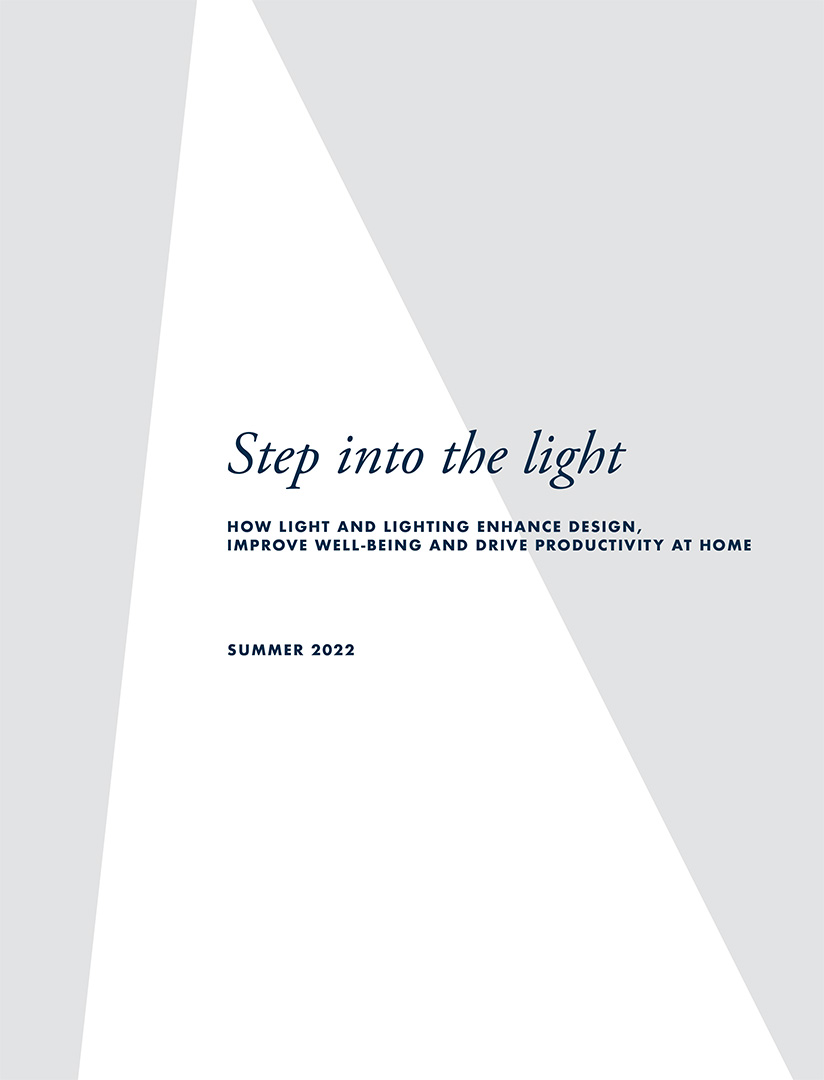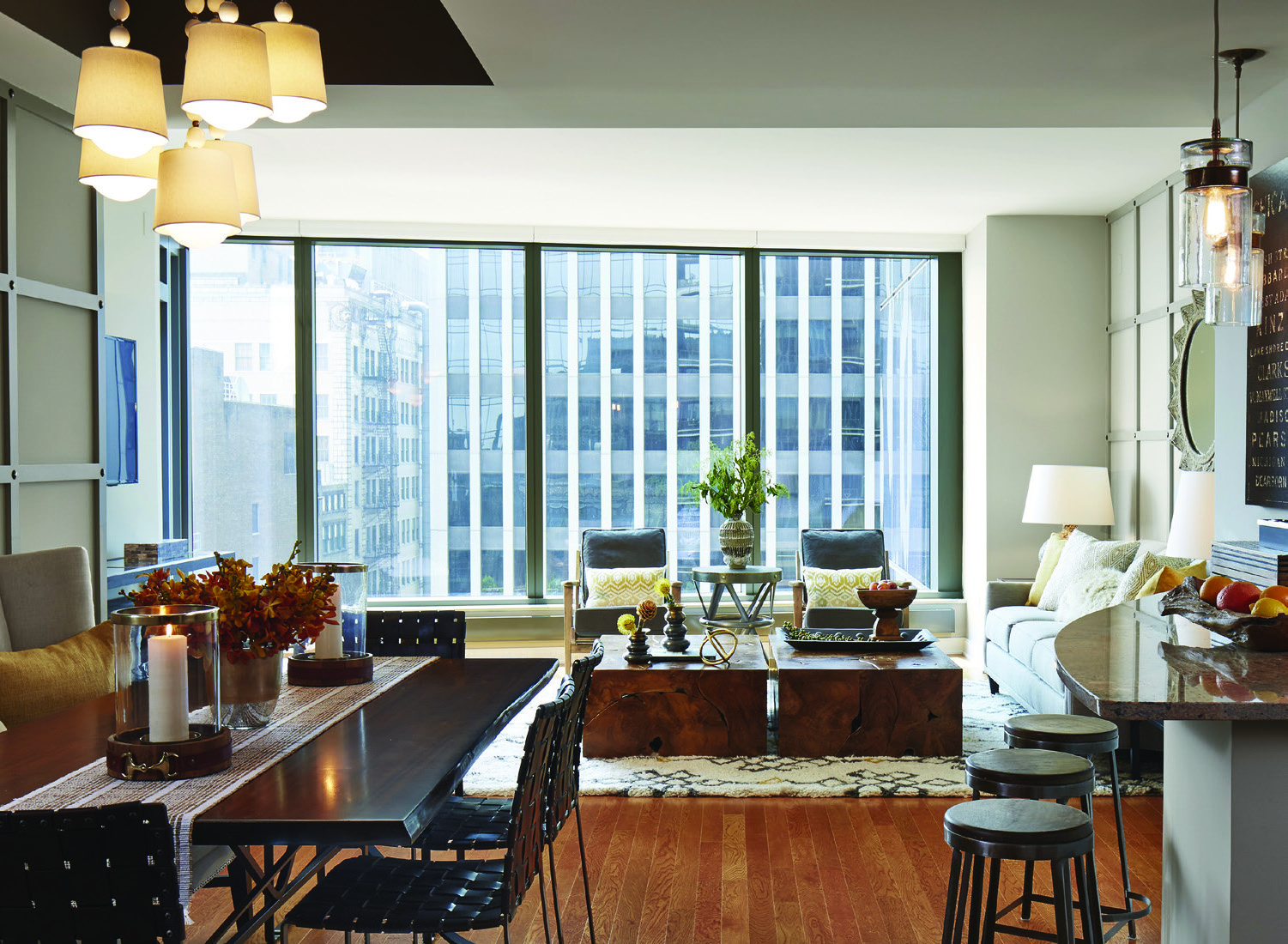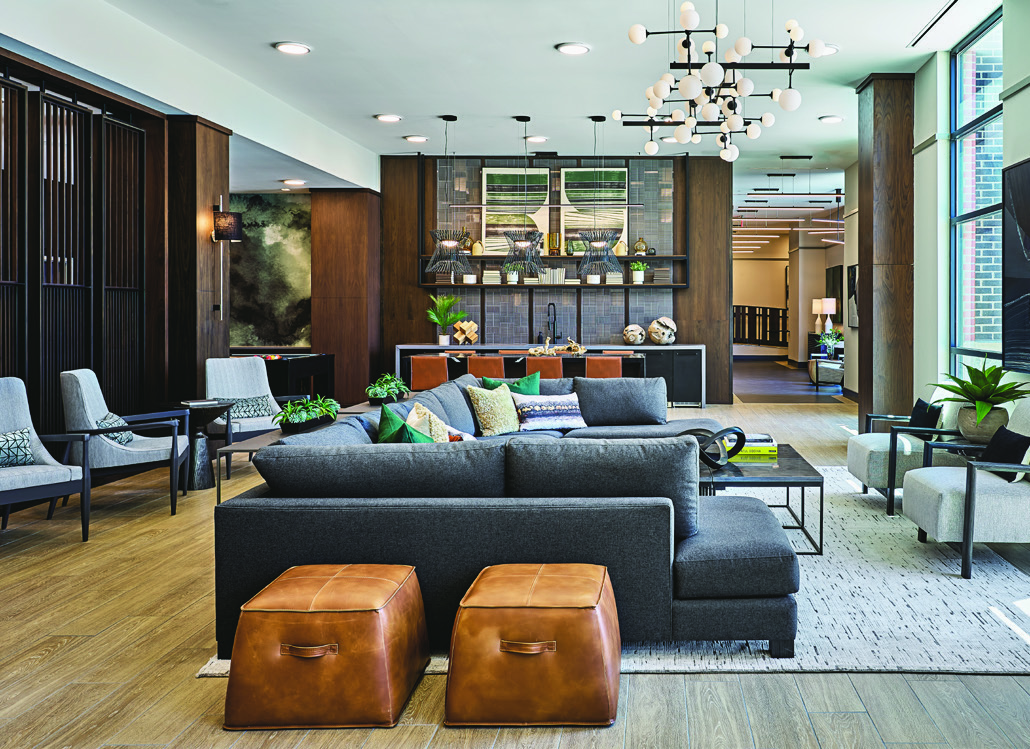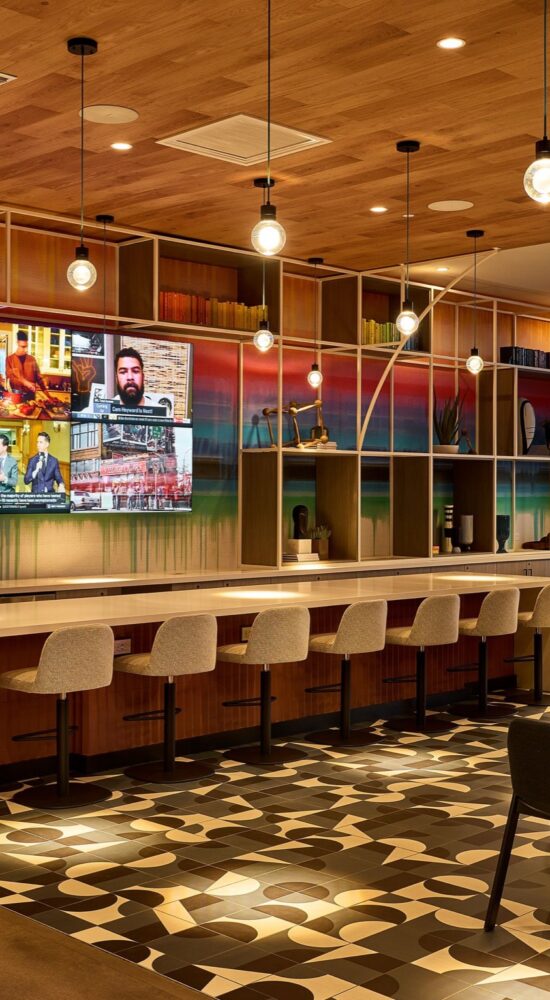The Curated Balance Of Natural And Artificial Lighting Creates An Elevated Experience At Chicago’s Legacy At Millennium Park.


We take light for granted.
When it gets dark, we just turn on a light. When the power goes out, we fire up a candle, a flashlight or our phone. In one way or another, it's always there. At least, it has been since the introduction of the incandescent light bulb in the 1880's. At first, the whole point – the only point – of artificial light was to allow us to see.
But almost immediately, people started pushing the limits of what lighting could do. On May 1, 1893, President Grover Cleveland pushed a button that turned on nearly 100,000 electric lights at Chicago's Columbia Exhibition. And nothing was ever the same again.
That Escalated Quickly
The century that followed saw the rapid advancement of light, both in technology and technique. Designers learned how we could actually alter our perceptions of space by layering light. Spaces with cathedral ceilings could be made to soar. Lights closer to the floor could 'lower' the ceiling and make a cavernous space feel intimate. Add lighting in between and the number of possibilities for creating moods and altering energy levels becomes staggering.
Today, some high-end restaurants use as many as 60 different bulb types to project just the right atmosphere in just the right place. You've certainly noticed how everything in the jewelry store has a seemingly impossible sparkle to it. And everyone recognizes that we feel different on rainy days versus sunny ones.
'Natural light is fundamental to all living things.'
-MARY COOK, FOUNDER AND PRESIDENT | MARY COOK ASSOCIATES
And today, we know that artificial light is fundamental to human performance, well-being, safety, and human experience. Lighting design and the complex art of 'creating the magic' in the places we experience isn't just complicated, it's more important than you know.

NATURAL LIGHT FLOODS A RESIDENT LOUNGE DURING DAYTIME THEN TRANSITIONS AS THE SUN SETS AND LAYERS OF ARTIFICIAL LIGHT ARE DIMMED AND ADJUSTED TO INSPIRE SOCIAL GATHERINGS AND RESIDENT INTERACTION.
IT’S TRUE
Light is magic
Power up – power down. Light changes the way we function and feel.
Light stimulates the production of serotonin, the hormone of happiness, and melatonin, the hormone that regulates our sleep. If we don't get the right amounts of the right kinds of light, we get fluctuations in the level of cortisol, the stress hormone, and that makes us feel drowsy.
The color, intensity, quality, and source/type of light also play critical roles in how we feel and experience a space. At one of our projects, a golf and country club, one member was overheard saying to her friend in the lady's locker room, 'I don't know what it is about this place, but I feel so pretty in here!'
In the same club, members were complaining that their steaks were overcooked. The chef had to resort to bringing members into the kitchen to see the steaks under a different light to prove they were not overcooked. Once the bulbs in the main dining room were changed out, there was never another complaint.
Research proves the point that lighting makes a difference when it comes to taste. A study conducted in a restaurant under varying types of lighting evaluated how brightness impacted overall taste. It concluded brighter light resulted in more intense flavors1. Another study found that low lighting positively influenced consumers’ perceived taste of a single taste dimension of foods such as its sweetness.2

'If lighting can affect the way we feel, the way we look, the way we see, how well we sleep, and the way we perform, shouldn't we as developers and designers be paying more attention? Absolutely. And we are.'
-JOSH KASSING | VP DESIGN DEVELOPMENT

LAYERED LIGHTING THAT ACCENTUATES KEY DESIGN ELEMENTS PUNCTUATES THE MAIN LOBBY ART WHILE CREATING A WELCOMING SOPHISTICATED AESTHETIC AT HIGHPOINT AT 8000 NORTH.
It's not all sweetness and light
But, while artificial light has given us incalculable possibilities, it has also caused some confusion in our bodies. Human beings have evolved for thousands of years to respond to the stimuli of sunlight in the day and darkness at night. It's called the 'Circadian Rhythm,' and it affects the rhythms of the human body. It influences sleep, mood, wakefulness, digestion, temperature control, immune response, and even cell renewal. Research shows that an adequate amount of light improves mood and energy levels while poor lighting contributes to depression and other deficiencies.
Everything that happens in our bodies is in response to the biological clock that is governed by the signals we get from light. We come by it naturally.
For millions of years, human beings were exposed to a pattern of sunlight in the morning gradually decreasing into the darkness of night. And at night, we weren't exposed to high intensity light. Our main source of light was the light from the moon, stars, and fire. After 1880, when electric lighting was invented, we spent more time indoors. Today, more than 90% of our time is spent indoors.
We spend a lot of time at night watching TV and surfing the internet. Our screens of choice are cell phones, tablets and computers. And we're in front of them late into the night. Our screens throw off a lot of blue light. There's more energy in the blue end of the spectrum and our bodies are really sensitive to it. According to the Sleep Foundation, blue light has significant impact on sleep interference.3 Evening exposure to blue light can trick our brain into thinking it's still daytime, disrupt circadian rhythms and leave us feeling alert instead of tired.
Chronic misalignment of circadian rhythms can also lead to many negative health impacts, including metabolic disorders and mental health conditions such as depression. A lot of experts believe it's a serious public health issue.
Right now, there's a lot of focus on the visual effects of light and without really considering the biological effects of light. We don't know what's really going on and we can't quantify it, so we don't connect the dots between our screens and the increases in insomnia, stress, fatigue and poor performance. But we are starting to see all these issues. When we finally realize what our devices have done to our bodies, it might be too late.
Lighting at work
During the Covid 19 shutdowns, while professionals of every type were suddenly working from home on makeshift desks, we noticed many people would move outside whenever the weather permitted. People noticed the difference natural light made during the day.
According to a study on the workplace of the future, those who are not exposed to a good amount of natural light are more likely to see a drop in their mood, and potentially—as a consequence—their productivity. The same study found that 38 percent of employees lose 60 minutes of time when their emotional wellness is suffering.4
Alan Hedge at Cornell University further confirmed the impact natural light has on work. His 2017 study found that office workers reported a 51 percent drop in eyestrain and a 63 percent drop in headaches as a result of more natural light exposure.5 In addition, workers sitting close to a window that optimized daylight exposure reported a 2 percent increase in productivity.
Besides productivity, some research concludes lighting also affects decision-making. Under bright lights emotions are felt more intensely. A University of Toronto under study found that participants in the brighter room experienced heightened emotions. They wanted spicier chicken wing sauce, thought the fictional character was more aggressive and felt better about positive words and worse about negative words.6 The researcher noted that since most everyday decisions are made under bright light, dimming the lights may boost more rational decision-making.
These findings illuminate the key role lighting plays in home offices and workspaces that are designed for optimal well-being and productivity. The nuances deepen with dual home offices. As John Burns New Home Insights reported, dual home offices for working couples became a high priority. More specifically, offices located at the rear of the home that had direct access to the yard's natural lighting was a must have. Today, in multi-family developments, we extend the co-working to the outdoors whenever we can. We do the same for yoga, fitness, grilling, gaming, and lounge areas.

MODERN FIXTURES PERFECTLY COMPLEMENT RECESSED LIGHTING TO HEIGHTEN FUNCTIONALITY AND A HIP VIBE IN THIS COMMON STUDY SPACE AT ASU'S CANVAS.

CAREFULLY CURATED LIGHTING DESIGN FOSTERS A SENSE OF CALM, COMFORT AND WELL-BEING IN A KINN GUEST HOUSE SUITE.
WE HAVE TO DO MORE THAN BEAUTIFUL
Seeing the light – in every room
With wellness at the forefront of consumers' minds and priorities, can we do more to better align the human biological rhythm with the way we light the spaces we live in? In today's remote-work/work-from-anywhere world, it's likely that rooms will need to perform differently at different times of day and year. Just like the way we use social lubricants like coffee to inspire deep thinking, debate, and work, or liquor when we want to inspire fun, socialization, and games, we can use light to enhance the way a room performs depending on what you want it to do.
Color Tuning technology exists in Smart LED lighting systems to easily tune the light color temperature and intensity to mimic the spectrum of daylight throughout the day. Full-spectrum light is mostly used in health care and learning environments. Cool white light with color temperatures of 3500 to 5000k are best for work or office settings during the day. Warm white light in the 1800 to 2700k range works best for residential settings and night. In residential apartments and homes, we carefully pair the wall and ceiling color with a warmer bulb color to inspire calm and relaxation. In co-working, fitness spaces, pet spas, and back-of-house areas we may use more bold and saturated color with cooler light temperatures that are more conducive to working and working out.
Resident lounges and gathering areas may have to do double duty. Flooded with natural light during the daytime, adjustable and dimmable lighting can be employed to transition the space as the sun sets, creating a variety of mood enhancing environments.
Clearly, this isn't your great-grandfather's light. We've gone from being able to read the paper at night to creating spaces that make us look and feel our best and even enhance our health and well-being. That's a pretty nice light to step into.
GET THE PDF VERSION HERE
MEET THE AUTHORS

Mary Cook, Founder and President
Mary Cook is the founder and president of Mary Cook Associates (MCA), a fully integrated interior architecture and design firm nationally known for creating innovative interiors that are targeted to market demands, designed to increase property value and deliver measurable returns. The firm's projects for premier owners and developers of real estate include multi-family, model homes, student living, senior living, clubhouses, restaurants, and hospitality environments. Under Mary's leadership, the work MCA produces emphasizes functionality, showcases possibilities, and accelerates sales and leasing. Currently celebrating its 35th anniversary, the firm continues its national presence with award-winning work that spans 36 states.

Josh Kassing, Vice President, Design Development
Josh Kassing is Vice President, Design Development at Mary Cook Associates (MCA). Serving as the leader of MCA's Concept Studio, he bridges business development, marketing, and design to develop and curate the firm's unique design approach. With nearly a decade of design experience for domestic and international commercial, residential and hospitality projects, he is a regular go-to source for the industry. His contemporary perspectives have been featured in podcasts, Mansion Global, The Wall Street Journal, Builder & Developer, Multi-family Executive, Multi-Housing News, Globe Street and IIDA Perspectives. He is also a frequent presenter at industry conferences.
Watch for our next white paper
that explores how color elevates design.
1 'The Effect of Ambient Light Brightness on Intensity of Flavor Perception,' Becca, theacademicwino, March 24, 2022, http://www.academicwino.com/2021/05/ambient-light-brightness-flavor-intensity.html/
2 'Less light, better bite: How ambient lighting influences taste perceptions,' Sarah Lefebvre, Jonathan Hasford, Laura Bomanc, Journal of Retailing and Consumer , Services, Volume 65, March 2022, https://www.sciencedirect.com/science/article/abs/pii/S0969698921002988
3 'How Blue Light Affects Sleep.' Rob Newsome, Sleep Foundation, April 12, 2022, https://www.sleepfoundation.org/bedroom-environment/blue-light#:~:text=In%20fact%2C%20the%202011%20National,with%20our%20natural%20sleep%20cycles
4 'Five Ways That Natural Light Improves Productivity in the Workplace,' Henry Martin, Occupational Health and Safety, November. 27, 2019, https://ohsonline.com/articles/2019/11/27/five-ways-that-natural-light-improves-productivity-in-the-workplace.aspx?m=1#:~:text=Those%20who%20are%20not%20exposed,their%20emotional%20wellness%20is%20suffering
5 'Study: Natural Light Is the Best Medicine for the Office,' Cornell University, January 31, 2018, https://www.newswire.ca/news-releases/study-natural-light-is-the-best-medicine-for-the-office-671936683.html
6 'New research shows the way a room is lit can affect the way you make decisions,' Toronto University, February 19, 2014, https://media.utoronto.ca/media-releases/education/new-research-shows-the-way-a-room-is-lit-can-affect-the-way-you-make-decisions/


